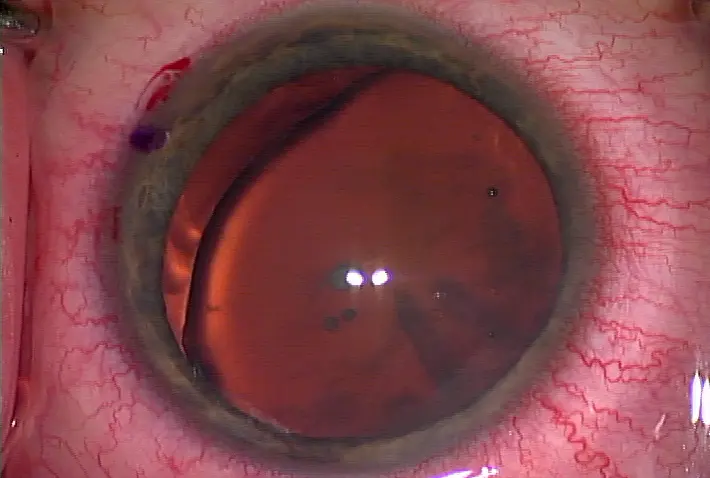Perioperative pharmacology Groundswell for NSAIDs in CME battle
Perioperative pharmacology
Groundswell for NSAIDs in CME battle
--------------------------------------------------------------------------------
by Maxine Lipner Senior EyeWorld Contributing Editor
The case pictured here required complete tarsorrhaphy and punctal plugs, and the patient ultimately healed with a residual scar and 20/40 vision Source: John R. Wittpenn, M.D.
Why practitioners see NSAIDs as a pivotal component
Nearly all cataract practitioners will tell you that NSAIDs are a vital part of practices' cystoid macular edema (CME) fighting regimen, despite the fact that this is an off-label use. "Some of the surveys suggest that in approximately 80% of cataract cases performed in the United States, patients are treated with topical NSAIDs at some point," said Michael B. Raizman, M.D., associate professor of ophthalmology, Tufts University School of Medicine, Boston. EyeWorld asked leading practitioners to share their thinking here.
Clear evidence
Dr. Raizman, who sees NSAIDs as an integral part of the CME prevention regimen, presented a randomized controlled study on prevention of CME with non-steroidal medication in 1999. The study in Investigative Ophthalmology and Visual Science compared the use of non-steroidal drugs together with steroids versus steroids alone. He found that 12% of low-risk patients given steroids alone developed CME compared with none of those who were treated with NSAIDs. In another pivotal study in the October 2008 issue of the American Journal of Ophthalmology, investigators led by John R. Wittpenn, M.D., explored whether the addition of perioperative topical ketorolac should be used with steroids in routine cases without known risk factors for cystoid macular edema. "The argument was that it's not worth it to use NSAIDs for these (low-risk) patients because they're not going to get CME," said Dr. Wittpenn, associate clinical professor, ophthalmology department, Stony Brook University, Stony Brook, N.Y. However, the study found that even low-risk patients were not immune to CME. These patients had a 2.5% risk of definite CME without the NSAID and virtually no CME risk with the drug. Meanwhile, for subclinical CME there was an 8.9% risk, making the risk together 11-12% for those who received steroid alone versus just 5% with the NSAID.
Clinical consequences
For Johnny L. Gayton, M.D., adjunct professor of ophthalmology, Mercer Medical School, Warner Robins, Ga., the clinical value indicated by the study is clear. "Dr. Wittpenn showed that a 10-micron thickening of the macular resulted in decreased contrast sensitivity," he said. For clinically significant CME this can translate into post-cataract acuity of 20/40 or worse. "Who's going to accept that?" he said. He also sees simple macular thickening as problematic. Dr. Gayton gave the analogy of using a fire hose on your carpet. "Ultimately you may get all of the water out, but that carpet won't ever fit like it did," he said. He pointed out that one of the risks here is reduced contrast sensitivity, and especially in the era of premium lenses, this can have serious consequences. Just a little bit of macular edema might tip a Tecnis Multifocal (Abbott Medical Optics, AMO, Santa Ana, Calif.) or a ReSTOR lens (Alcon, Fort Worth, Texas) away from success.
The cost factor
Dr. Wittpenn views the data here as helping to elucidate the economics involved. "I understand that everything is a risk-benefit choice, an economic choice, but at least your patients can make the choice of whether reducing the risk from 2.5% definite CME or perhaps 12% of some measureable effect on the macular down to 0-4% is worth the $200 it is going to cost your patients to buy the medicine," he said.
CME is also very difficult to treat, pointed out Keith Walter, M.D., associate professor of ophthalmology, Wake Forest University, Winston-Salem, N.C. "Once it's there it is hard to get rid of," Dr. Walter said. "Some people need very expensive long-term treatment." This can come in the form of steroid injections inside of the eye or the Ozurdex implant (Allergan, Irvine, Calif.), which Dr. Walter pointed out can be about $800 for each implant. By comparison the NSAID is a bargain. "One bottle of Bromday [bromfenac, ISTA Pharmaceuticals, Irvine, Calif.] retails for about $160, but with insurance it can be as low as $6 for a bottle," he said. "The most I've seen patients pay is about $50 for a co-pay."
Deliberating the regimen
Frequency of recommended NSAID use can fluctuate. This varies depending upon which non-steroidal you're using, Dr. Gayton pointed out. "If you're using Nevanac [nepafenac, Alcon], it should be given three times a day, and if you're using diclofenac or ketorolac [Acular, Allergan], they should be given four times a day," he said. "But if you're using Bromday, it should be given only once a day." Dr. Raizman stressed that NSAIDs in the approval process haven't been studied for CME but rather for inflammation. "For the prevention of CME, I don't know the right dose, but I'd rather err on the side of using a slightly higher dosing schedule," he said. "I'm not currently [dosing] once a day with any of the products regardless of what the label is for post-cataract inflammation."
Overall, Dr. Wittpenn believes that NSAIDs have a role in cataract surgery for all patients. "If I was having my own eyes operated on I would use a non-steroidal, and I would use a brand non-steroidal [see sidebar]," he said. "If that's what I would do with my own eyes, that is what I recommend to my patients."
Editors' note: Dr. Gayton has financial interests with Alcon and ISTA Pharmaceuticals. Dr. Raizman has financial interests with Alcon, Allergan, Bausch + Lomb (Rochester, N.Y.), and ISTA. Dr. Walter has financial interests with ISTA and Merck (Whitehouse Station, N.J.). Dr. Wittpenn has financial interests with Bausch + Lomb and ISTA.
Contact information
Gayton: 478-923-5872, jlgayton@aol.com
Raizman: 617-314-2656, mbraizman@eyeboston.com
Walter: 336-716-4091, kwalter@wakehealth.edu
Wittpenn: 631-941-3363, jrwittpenn@aol.com




留言
張貼留言